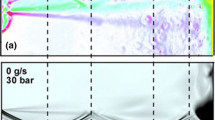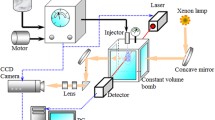Abstract
Cold spray is a technique to make a coating on a wide variety of mechanical or electric parts by spraying solid particles accelerated through a high-speed gas flow in a converging-diverging nozzle. In this study, pseudo-shock waves in a modeled cold spray nozzle as well as high-speed gas jets are visualized by schlieren technique. The schlieren photographs reveals the supersonic flow with shock train in the nozzle. Static pressure along the barrel wall is also measured. The location of the head of pseudo-shock wave and its pressure distribution along the nozzle wall are analytically explained by using a formula of pseudo-shock wave. The analytical results show that the supersonic flow accompanying shock wave in the nozzle should be treated as pseudo-shock wave instead of normal shock wave.
Similar content being viewed by others
Abbreviations
- D :
-
diameter (m)
- M :
-
Mach number
- p :
-
static pressure (Pa)
- R e :
-
Reynolds number
- x :
-
axial distance (m)
- ϑ :
-
Momentum thickness
- 0:
-
stagnant condition
- 0s :
-
stagnation chamber
- 1:
-
just before shock wave
- 2:
-
just after normal shock wave
- b :
-
atmospheric condition
- e :
-
barrel exit
- s :
-
shock wave
References
Kawakita, J., Kuroda, S., Krebs, S., Katanoda, H.: In-situ Densification of Ti Coatings by the Warm Spray (Two-Stage HVOF) Process, Mater. Trans., vol.47(7), pp.1631–1637, (2006).
Wu, C., Okuyama, M.: Evaluation of High Temperature Corrosion Resistance of Al Plasma Spray Coatings in Molten Sulfates at 1073 K by Electrochemical Measurements, Mater. Trans., vol.37(5), pp. 991–997, (1996).
Papyrin, A.: Cold Spray Technology. Advanced Materials & Processes, vol.159(9), pp.49–51, (2001).
Stoltenhoff, T., Kreye, H., Richter, H. J.: An Analysis of the Cold Spray Process and Its Coatings. J. Thermal Spray Technol., vol.11(4), pp.542–550, (2002).
Sakaki, K., Shinkai, S., Ebara, N., Shimizu, Y., Tamaki, K., Kurisu, Y.: Nozzle Design and its Property for Low Powder Feed Pressure of Cold Spray. In: Proc. Natl. Joint Conf. on Thermal Spray 2005, Osaka, Japan., pp. 27–28, (2005).
Matsuo, K.: On the Pseudo-Shock Waves, Nagare, vol.6(4), pp. 308–318, (1987).
Matsuo, K., Miyazato, Y., Kim, H. D.: Shock Train and Pseudo-shock Phenomena in Internal Gas Flows. Progress in Aerospace Sciences, vol.35(1), pp. 33–100, (1999).
Katanoda, H., Yamamoto, H., Matsuoka, T., Matsuo, K.: Gasdynamic Study on Flow Characteristics of High Velocity Oxy-Fuel Thermal Spray Gun (1st Report, The Influence of Chamber Pressure and Barrel Length). Trans. JSME B, vol. 72(714), pp. 271–278, (2006).
Waltrup, P. J., Billig, F. S.: Structure of Shock Waves in Cylindrical Ducts. AIAA J., vol.11(10), pp. 1404–1408, (1973).
Bement, D. A., Stevens, J. R., Thompson, M. W.: Measured Operating Characteristics of a Rectangular Combustor/Inlet Isolator. AIAA Paper, No. 90-2221, (1990).
Author information
Authors and Affiliations
Rights and permissions
About this article
Cite this article
Katanoda, H., Matsuoka, T. & Matsuo, K. Experimental study on shock wave structures in constant-area passage of cold spray nozzle. J. of Therm. Sci. 16, 40–45 (2007). https://doi.org/10.1007/s11630-007-0040-3
Received:
Issue Date:
DOI: https://doi.org/10.1007/s11630-007-0040-3




